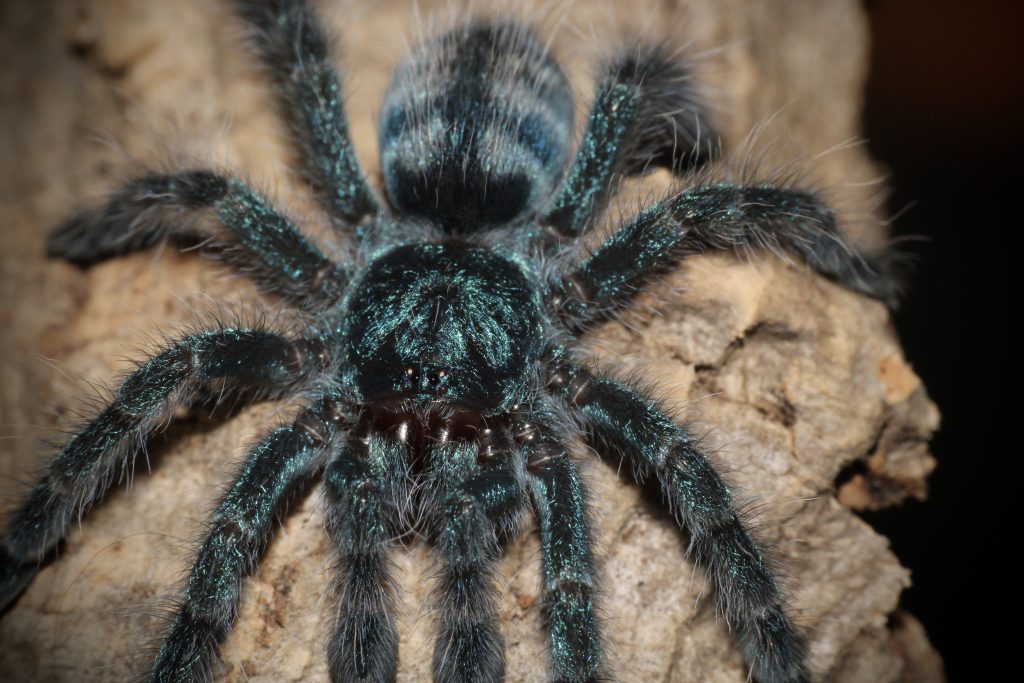Copyright 2021 Evolution Reptiles
All rights reserved.
Copyright 2025 Evolution Reptiles
All rights reserved.
All rights reserved.
Many of the brightest and most colourful species of tarantula are old world species, the majority of which have a bad attitude and a habit of running – fast. This species is a very welcome exception to that rule. With bright blues, reds and purples the Martinique pinktoe is one of the most aesthetically pleasing tarantulas around.
In the Caribbean, on the island of Martinique, this spider resides in a variety of microhabitats which they modify using their webbing in order to create hammocks and tubes. It is within these that they spend the vast majority of their time, waiting for unsuspecting prey items to walk by. Ambient temperatures frequently reach 28ºC in Martinique and stay warm all year round, with the coolest and driest season falling between January and April. The rainy season happens in unison with the warmest time of year; between June and November which means that for this period there is a high ambient humidity.

When setting up an enclosure for this species, remember that this is a completely arboreal species meaning that it will almost always spend time off of the floor. Therefore, you need to ensure that the enclosure is of a suitable height. A minimum height of 45cm is recommended for an adult. With an adult female reaching a leg span of up to 15cm, it’s a good idea to keep to a similar ratio for younger specimens too. A layer of substrate at the bottom of at least an inch in depth is recommended as this while aid in maintaining humidity. Perhaps the most important consideration for this species is whether or not the enclosure we plan on using provides ample ventilation. A good airflow is vital for keeping this species effectively and, while they do appreciate a higher humidity than some species, a damp enclosure without any ventilation will surely kill the animal in question. Most of the time this is best achieved by using an enclosure with ventilation somewhere roughly in the middle, as well as on the top. Alternatively, front opening enclosures also help to offer better ventilation. We always recommend the use of a small, shallow water bowl, especially for bigger specimens. A heat source is also recommended for these spiders, a low wattage (below 10w) heat mat attached to the outside of one of the side walls can work well in order to create a temperature gradient. A thermostat is always advised in order to prevent overheating, especially with higher wattage mats. Temperatures over 30ºC are potentially fatal and should be avoided.
As previously stated, the C. versicolor likes to create its own hammock or tube where it will sit and feel most secure. It’s a good idea to furnish the enclosure with plenty of branches/ foliage so that the spider can use these as anchor points when webbing. The webs are normally made at the very top of the enclosure or near to it. Therefore, anything that is top opening doesn’t tend to be the most appropriate as you will find yourself damaging this construction, stressing out the spider in the process.
Maintaining a suitable environment for these animals isn’t taxing but does require an understanding of their needs. It’s recommended to spray one half/ one wall of the enclosure with warm water once a week. While you want to maintain a decent humidity, a common mistake made with this species is creating damp conditions which can be fatal. If the enclosure has adequate ventilation this will be less of a concern. Younger specimens are far more sensitive to low humidity as they dehydrate much quicker than adults. Therefore it’s important to stay on top of the spraying routine, especially with spiderlings. They will need to be fed either once or twice weekly, with an appropriately sized invertebrate. We’ve found that this species will take a variety of food; crickets, locusts and cockroaches should be offered as the staples of their diet. Spiderlings will regularly take fruit flies or an equivalent, smaller sized prey item.
The temperament of these spiders really is second to none when we’re talking about arboreal tarantulas. Like anything that lives above the ground, they are slightly faster than a lot of terrestrial species. However, they will most often bolt in short bursts before slowing down again. This means that they are easy to work with and predictable with their movements. They almost always walk with their legs pointing towards the sky, almost as if they’re on hot coals. This is simply because they are looking for something above them to climb on as they will always aim to move upwards. We strongly recommend not handling any species of tarantula, regardless of temperament.
Copyright 2021 Evolution Reptiles
All rights reserved.